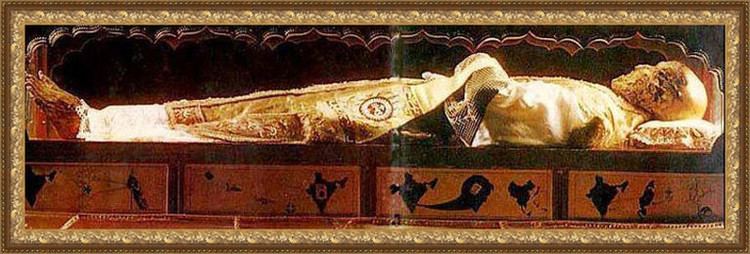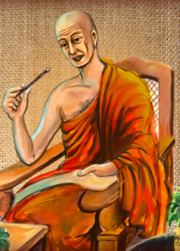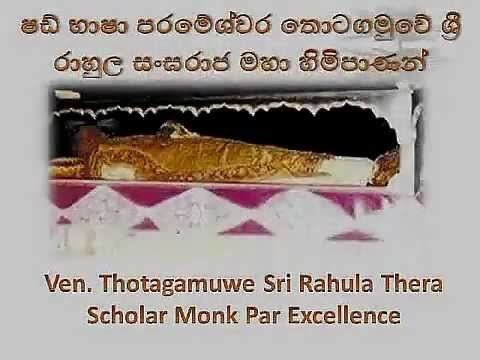Name Thotagamuwe Rahula | School Theravada | |
 | ||
Teacher Uthurumula Rahula TheraWilgammula TheraWidagama Maithrie Thera Born 1408 (age 82) Dematana, Kegalle District Died 1491 (aged 82) Ambana Indurugiri cave, Elpitiya, Galle District | ||
Thotagamuwe Sri Rahula Thera (1408 - 1491) was a Buddhist monk and an eminent scholar, who lived in the 15th century in Sri Lanka. He was a multi-linguist who was given the title "Shad Bhasha Parameshwara" due to his mastery in six oriental languages which prevailed in the Indian subcontinent. Sangharaja Thotagamuwe Sri Rahula Thera was also a distinguished author, veteran astrologer and a proficient ayurvedic physician.
Contents
- what happened to thotagamuwe sri rahula thera
- Biography
- Literary works selection
- Folklore and mortal remains
- References

what happened to thotagamuwe sri rahula thera
Biography

Thotagamuwe Sri Rahula thera was born in 1408 at Dematana, a village close to Dedigama in Kegalle District. His lay name was Jayaba. Though his parentage is uncertain, some sources reveal that his mother was the elder sister of queen Keerawelle Kumari, who was the chief consort of King Parakkramabahu VI of Kotte. Accordingly, his mother was princess Seelawathi and his father was prince Wickramabahu. Since prince Jayaba's mother died when he was an infant, he was kept under the guardianship of King Parakkramabahu VI and his wife. Prince Jayaba had his education initially under Uthurumula Rahula thera and Wilgammula thera who were also relatives of him. They have ordained prince Jayaba as a novice monk and was given the religious name Wachissara Rahula thera.

After getting ordained as a Buddhist monk young Rahula thera moved to the Wijayabha pirivena of Thotagamuwa for his further education. Vijayaba Pirivena in Thotagamuwa, Hikkaduwa in Galle District served as the most renowned and popular education center of the Kotte era. King Vijayabahu I of Polonnaruwa was the founder of this famous pirivena which has produced many oriental scholars to the country. In a short period of time young Rahula thera acquired a wide knowledge in literature, oriental languages and Buddhist scriptures. He was well competent in reciting the entire Tripiṭaka by rote and amused his teachers and the king. It was at Vijayaba Pirivena in Thotagamuwa, Sri Rahula thera spent most of his life and created some of his most famous literary works. Later he succeeded his grandfather Uthurumua Rahula thera and Galthurumula thera as the chief prelate of Vijayaba Pirivena in Thotagamuwa, Hikkaduwa. Thotagamuwe Sri Rahula Thera was also the first Sri Lankan bhikkhu to obtain the post of Sangharaja, which was conferred on him by King Parakramabahu VI.

There are two legendary stories regarding the latter life of Thotagamuwe Sri Rahula thera. One version is that after rendering a yeoman service to the Sinhalese literature, Thotagamuwe Sri Rahula thera died peacefully circa 1491. It is said due to the effect of an Ayurvedic drug named "Siddaloka Rasaya" which was taken by Sri Rahula thera, his body did not decompose as a usual dead body and kept growing beard and nails. Because of this mysterious nature of the cadaver it was not cremated as usual. The cadaver of Sri Rahula thera was kept at Vijayaba pirvena for some time, until the arrival of Portuguese invaders to Sri Lanka in 1505. Villagers who feared a possible abduction of this mysterious body by the Portuguese, took it to the Indurigiri cave at Ambana near Elpitiya in Galle District which was surrounded by a dense forest cover for safety.
The other version is that Thotagamuwe Sri rahula thera departed Vijayaba Pirivena to Obbegoda temle in Monaragala District to spend his retirement peacefully. After staying there for few years he moved to Dickwella in Matara District where he stayed briefly before finally settling down at Indurugiri cave in Ambana close to Elpitiya, where he stayed until his death in 1491.
There has been a fight between the villagers and Portuguese at a place called Aviluma over the cadaver which was placed in a stone boat. It is said that there were demons or spirits who were protecting the cadaver, but with the help of treacherous locals, the Portuguese manged to shove them away.
Literary works (selection)
Thotagamuwe Sri Rahula Thero was a pillar in Sri Lankan literature, who authored a number of highly reputed Sinhala literary works. Some of his notable creations are:
Folklore and mortal remains
There are many folklore stories regarding Sri Rahula Thera's life from his childhood until death. Though he was a child prodigy, he was a kind of a mischievous character who loved adventures. One famous story is that he drank an entire bottle of a medicinal oil called "Saraswathi oil" which helps to boost memory power, whereas it is prescribed to use only a drop. It is believed that due to the effect of this medicinal oil, Thotagamuwe Sri Rahula Thero had extraordinary memory powers throughout his life. In the local lore and legend it is also said that Thotagamuwe Sri Rahula Thera was an exorcist who had controlled demons by mantra to do manual labor work.
According to the view of some historians and critics, the mortal remains kept in the Basilica of Bom Jesus in Goa, India, is the in-corrupt body of Thotagamuwe Sri Rahula Thera, which was smuggled by the Portuguese from the remote village of Ambana in Southern Sri Lanka. It is believed that due to the effect of the Ayurvedic drug named 'Siddalaoka Rasaya', which he had taken during the latter part of his life, his body continues to remain intact without decomposing till the year 4230 AD.
